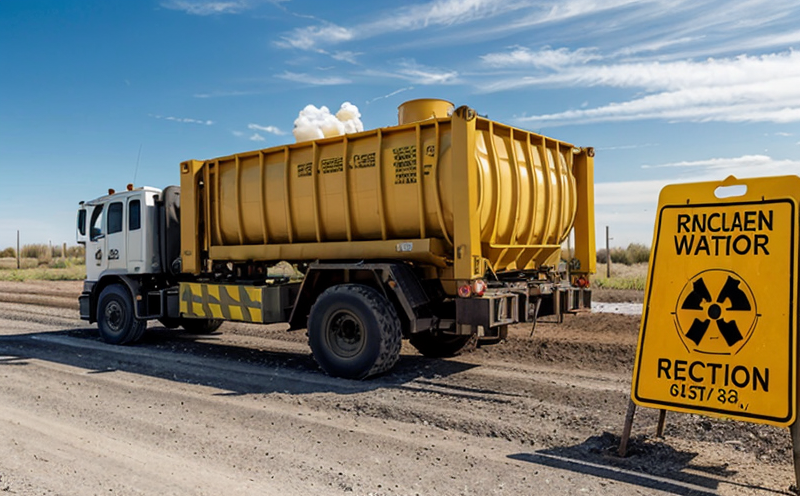ASTM C1767 Radiochemical Analysis of Cesium-137 in Waste
The ASTM C1767 standard method provides a robust framework for the radiochemical analysis of Cesium-137 (Cs-137) in radioactive and nuclear waste. This service is crucial for ensuring regulatory compliance, environmental safety, and accurate waste characterization. Cesium-137, with its high-energy gamma rays, plays a critical role in various applications such as radiation therapy, industrial gauging, and power generation. Its presence must be accurately quantified to manage hazardous materials responsibly.
The process begins with the selection of appropriate samples from the waste stream. These samples are typically collected under controlled conditions to ensure representativeness. The next step involves a series of chemical separations designed specifically for Cs-137, which may include solvent extraction, ion exchange, and precipitation techniques. This meticulous separation ensures that only the desired radionuclide is isolated for analysis.
Once purified, the sample is subjected to gamma spectroscopy using high-purity germanium (HPGe) detectors. These detectors are capable of detecting the characteristic energy peaks of Cs-137 with precision and accuracy. The HPGe system’s ability to differentiate between various isotopes ensures reliable quantification even in complex mixtures.
The analysis is performed under strict quality control protocols to ensure reliability. This includes regular calibration checks, verification against reference materials, and proficiency testing. Compliance with ASTM C1767 not only meets regulatory requirements but also enhances the credibility of the results for stakeholders involved in waste management, environmental protection, and public health.
The reported values are presented as activities per kilogram (Bq/kg) or picocuries per gram (pCi/g), depending on client preferences. These units provide a clear metric for comparing Cs-137 concentrations across different samples and sites. The service also includes a detailed methodology section in the report, which guides readers through each step of the analysis process.
The ASTM C1767 method is widely recognized for its precision and accuracy, making it an indispensable tool in the nuclear industry. It ensures that waste management practices are aligned with international standards such as IAEA (International Atomic Energy Agency) guidelines. This alignment is crucial for maintaining safety protocols and ensuring that all stakeholders can trust the analysis results.
Understanding the context of radioactive waste management is essential to appreciate the significance of this service. Radioactive materials pose significant risks if not handled properly, making accurate quantification a necessity. By employing ASTM C1767, laboratories ensure they are meeting global best practices and contributing to safer environments for all.
Applied Standards
| ASTM Standard | Description |
|---|---|
| ASTM C1767-19a | Standard Practice for Radiochemical Determination of Cesium-137 in Waste |
| ISO 8529-4 | Guidelines for the Sampling and Analysis of Radionuclides in Waste |
| IEC 60502 | Technical Specifications for Gamma Spectrometry |
| EN 13794-2 | Guidelines for the Management and Treatment of Radioactive Waste |
The ASTM C1767 standard is the cornerstone of this service, providing a standardized approach to quantifying Cs-137 in waste. This method ensures that all samples are analyzed under consistent conditions, leading to reliable and reproducible results. Other standards like ISO 8529-4 provide additional context on sampling techniques and analysis methods, while IEC 60502 sets the technical specifications for gamma spectroscopy equipment.
Together, these standards ensure that the analysis of Cs-137 is conducted in a manner that meets international best practices. This not only enhances the accuracy of the results but also ensures compliance with regulatory requirements across different jurisdictions.
Benefits
The implementation of ASTM C1767 radiochemical analysis offers numerous advantages to stakeholders involved in waste management and recycling:
- Regulatory Compliance: Ensures adherence to international standards and regulatory requirements.
- Enhanced Safety: Provides accurate quantification of Cs-137, reducing the risks associated with radioactive waste handling.
- Precision in Reporting: Offers detailed reports that are crucial for decision-making processes.
- Cost Efficiency: Minimizes errors and rework by ensuring accurate initial analysis.
- Environmental Protection: Contributes to responsible waste management practices, protecting the environment from potential hazards.
- Client Trust: Provides reliable data that enhances trust among clients and regulatory bodies.
The precision and reliability of this service are paramount in ensuring that radioactive materials are managed safely and effectively. By adhering to ASTM C1767, laboratories can demonstrate their commitment to environmental stewardship and public safety.





